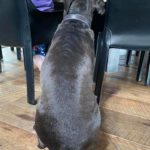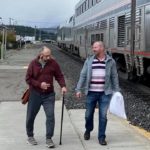Truckee, California, May 2021
*posted late
The California Zephyr runs from Chicago to the San Francisco Bay Area, cutting a path through two formidable mountain ranges and evoking the history of America’s westward migration. During its many decades of service, the Zephyr’s principal contribution to society has been the creation of several generations of complete liars. The Zephyr delivered two such liars, my father and stepmother, to Truckee this past weekend. They boarded the train in Omaha for a two-night, 1300-mile journey. When they disembarked at the Truckee station, helped off the side of the double-decker monstrosity onto a plastic stool by an Amtrak employee who was only vaguely interested in whether they fell face forward onto the pavement, I asked how they enjoyed the train ride. They said—immediately and in unison—“oh, it was great … a once-in-a-lifetime experience.” Well, then, why do you look like hikers just find you in the woods surviving on grubs and berries? They asked if I’d be willing to hear the truth in exchange for my silence. Sure, I promised, I won’t say a word.
Turns out taking the Zephyr is like getting stuck on the Tilt-A-Whirl and finding that the carnival operators have all gone home for the weekend. For the survivors, carrying on the myth of a glorious train ride across the American plains and over the mountains is all they have left.
Confined to the house most days due to the realities of age and the sedentary year gone by—not to mention the altitude—Hollywood provided much of our entertainment. Everything goes so well on television. The writers and directors make sure of it. The stories are compressed in time and punctuated with drama and laughter to keep us hooked. And every show has a satisfying ending. In the Big Sick, the couple stayed together after a tumultuous journey. In Bridesmaids, a character down on her luck ends up with the friendly cop. In The Jinx, the suspected murderer confesses to all of his crimes on a hot mic after the final interview.
Even the makers of nature documentaries, limited by the footage they could capture, portray the struggles of survival but still set us down gently. Take Charm for example, a lioness filmed struggling to keep her dwindling pride fed with the help of the great wildebeest migration across the Maasai Mara. We learn Charm is an expert hunter able to take down large animals with minimal effort. Through the animals’ interactions, we see the pride’s close family bonds and the respect they have for Charm. When the wildebeests disappear, the pride wanders farther and the lions end up poisoned by an illegal rancher protecting his cattle. All recover except for Charm’s son, who is too weak to follow the pride to new territory and food. The sickened lion watches between grass blades as the pride leaves him. But in a gripping scene, Charm returns the next day to see if her son is alive. We see him stand and lean on his mother before collapsing again to the ground. Charm has only one choice. We watch her leave her dying son. In the outtakes we learn that the filmmakers broke objectivity and intervened to try and save the young lion. Of course they would, because we poisoned him, we humans. But they delayed, choosing to first see if Charm would return. These undoubtedly heartbroken crew members must have done this for the next generation of lions by giving us a moment to reflect on our commonality. The episode concludes with scenes of Charm nursing her rambunctious new cubs.
After all of these shows, our own Charm, Tony, made sure we were all fed. A flurry of activity in the kitchen, not unlike the billowy takedown of a wildebeest, produced one fine meal after another. The most well-fed animal in the house, however, was Harvey. Harvey discovered my Dad’s willingness to buy his love by carrying treats in his pocket. Harvey began the week rewarding my Dad and Randi with love and attention, snubbing us to lounge on the couch next to them. By the end of the week, however, the relationship between Harvey and my Dad had devolved into one resembling that of an addict and his dealer.
The dramatic weather during the week turned us all into documentarians. Randi snapped photos through the windows as the dry hot weather turned rapidly to rain, snow, and sleet. Tony flew the drone into the sky to capture the drama of the May snowstorm. And at week’s end, we watched in the rain as the Zephyr lumbered into the Truckee station and everyone guessed which door would open and produce the plastic stool.
While the California Zephyr is not the Orient Express or the Trans-Siberian Express, it can claim its own magnificence. Traveling eastward through Utah, the Zephyr begins a great ascent, first to the meadows of the Colorado Plateau and then higher as it crosses one of the most stunning mountain ranges on Earth. In this Hollywood ending, its weary passengers are jolted awake in the early morning to discover an eerie glow illuminating their cramped quarters. Curiosity sends them stumbling to the window where they pull open the tattered curtains just as the side of the train catches fire. Blinded by the flames ricocheting along the metallic cars, they shield their eyes. As they adjust to the light, they realize they are witnessing the blazing sun as it rises through the crooked peaks of the Rocky Mountains.








